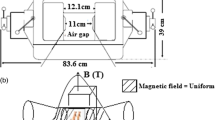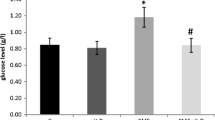Abstract
The purpose of this study was to investigate the effect of subacute exposure to static magnetic fields (SMF) on hematological and muscle biochemical parameters in rats. Male Wistar rats, daily exposed to SMF, were exposed to SMF (128 mT, 1 h/day) during 15 consecutive days. SMF-exposed rats showed a significant decrease in red blood cell (RBC) count, hemoglobin (Hb), and hematocrit (Ht) values compared to sham-exposed rats (p < 0.05). Concomitant decreases of plasma iron level against increase in transferrin amount were also observed after SMF exposure (p < 0.0.05). In postprandial condition, SMF-exposed rats presented higher plasma lactate (p < 0.01). Additionally, SMF exposure increased monocarboxylate transporters (MCT4) and glucose transporter 4 (Glut4)’s contents only in glycolytic muscle (p < 0.05). SMF exposure induced alteration of hematological parameters; importantly, we noticed a pseudoanemia status, which seems to affect tissue oxygen delivery. Additionally, SMF exposure seems to favor the extrusion of lactate from the cell to the blood compartment. Given that, these arguments advocate for an adaptive response to a hypoxia status following SMF exposure.





Similar content being viewed by others
References
Abdelmelek H, Molnar A, Servais S, Cottet-Emard JM, Pequignot JM, Favier R, Sakly M (2006) Skeletal muscle HSP72 and norepinephrine response to static magnetic field in rat. J Neural Transm 113(7):821–827
Ali FM, Mohamed WS, Mohamed MR (2003) Effect of 50 Hz, 0.2 mT magnetic field on RBC properties and heart functions of albino rats. Bioelectromagnetics 24(8):535–545
Andrews NC (2000) Iron metabolism: iron deficiency and iron overload. Annu Rev Genomics Hum Genet 1(75–98):1527–8204
Atef MM, MS A e-B, el-Kareem A, Aida S, Fadel MA (1995) Effects of a static magnetic field on haemoglobin structure and function. Int J Biol Macromol 17(2):105–111
Avogaro A, Toffolo G, Miola M, Valerio A, Tiengo A, Cobelli C, Del Prato S (1996) Intracellular lactate- and pyruvate-interconversion rates are increased in muscle tissue of non-insulindependent diabetic individuals. J Clin Invest 98(1):108–115
Berg H (1993) Electrostimulation of cell metabolism by low frequency electric and electromagnetic fields. Bioelectrochem Bioenerg 31(1):1–25
Binhi VN (2002) Magnetobiology: underlying physical problems. Academic, San Diego
Cabrales LB, Ciria HC, Bruzón RP, Quevedo MS, Céspedes MC, Salas MF (2001) ELF magnetic field effects on some hematological and biochemical parameters of peripheral blood in mice. Electromagn Biol Med 20(2):185–191
Cakir DU, Yokus B, Akdag MZ, Sert C, Mete N (2009) Alterations of hematological variations in rats exposed to extremely low frequency magnetic fields (50 Hz). Arch Med Res 40(5):352–356
Chater S, Abdelmelek H, Pequignot JM, Sakly M, Rhouma KB (2006) Effects of sub-acute exposure to static magnetic field on hematologic and biochemical parameters in pregnant rats. Electromagn Biol Med 25(3):35–144
DiGirolamo M, Newby FD, Lovejoy J (1992) Lactate production in adipose tissue: a regulated function with extra-adipose implications. FASEB J 6(7):2405–2412
Djordjevich DM, De Luka SR, Milovanovich ID, Jankovic S, Stefanovic S, Veskovic-Moracanin S, Cirkovic S, Ilic AZ, Ristic-Djurovic JL, Trbovich AM (2012) Hematological parameters’ changes in mice subchronically exposed to static magnetic fields of different orientations. Ecotoxicol Environ Safety 81(1):98–105
Elferchichi M, Abdelmelek H, Sakly M (2007) Effects of sub-acute exposure to static magnetic field on iron status and hematopoiesis in rats. Turk J Haematol 24(2):64–68
Elferchichi M, Mercier J, Coisy-Quivy M, Metz L, Lajoix AD, Gross R, Belguith H, Abdelmelek H, Sakly M, Lambert K (2010) Effects of exposure to a 128-mT static magnetic field on glucose and lipid metabolism in serum and skeletal muscle of rats. Arch Med Res 41(5):30914
Elferchichi M, Mercier J, Bourret A, Gross R, Lajoix AD, Belguith H, Abdelmelek H, Sakly M, Lambert K (2011) Is static magnetic field exposure a new model of metabolic alteration? Comparison with Zucker rats. Int J Radiat Biol 87(5):48390
Eydoux N, Dubouchaud H, Py G, Granier P, Prefaut C, Mercier J (2000a) Lactate transport in rat sarcolemmal vesicles after a single bout of submaximal exercise. Int J Sports Med 21(6): 393–9
Eydoux N, Py G, Lambert K, Dubouchaud H, Prefaut C, Mercier J (2000b) Training does not protect against exhaustive exercise-induced lactate transport capacity alterations. AJP Endocrinology and Metabolism. 278 (6): 1045–52
Feychting M (2005) Health effects of static magnetic fields: a review of the epidemiological evidence. Prog Biophys Mol Biol 87(2–3):241–246
Gutmann I, Wahlefeld M (1974) L (þ) lactate determination with lactate dehydrogenase and NAD. Methods of enzymatic analysis. Academic, New York, pp 1464–1472
Hashish AH, El-Missiry MA, Abdelkader HI, Abou-Saleh RH (2008) Assessment of biological changes of continuous whole body exposure to static magnetic field and extremely low frequency electromagnetic fields in mice. Ecotoxicol Environ Safety 71(3):895–902
Hassan NS, Abdelkawi SA (2010) Changes in molecular structure of hemoglobin in exposure to 50 Hz magnetic fields. Nature 8(8):236–243
Havas M (2008) Dirty electricity elevates blood sugar among electrically sensitive diabetics and may explain brittle diabetes. Electromagn Biol Med 27(2):135–146
James JH, Luchette FA, McCarter FD, Fischer JE (1999) Lactate is an unreliable indicator of tissue hypoxia in injury or sepsis. Lancet 354(9177):505–508
Juel C, Halestrap AP (1999) Lactate transport in skeletal muscle: role and regulation of the monocarboxylate transporter. J Physiol 517(3):633–642
Kowalczuk CI, Sienkiewiczk ZJ, Saunders RD (1991) Biological effects of exposure to non-ionizing electromagnetic fields and radiation I. Static electric and magnetic fields. National Radiological Protection Board, NRPB-R238, Didcot, UK
Kula B, Drozdz M (1996) A study of magnetic field effects on fibroblasts cultures, part 2: The evaluation of effects of static and extremely low frequency (ELF) magnetic fields on free radical processes in fibroblasts cultures. Bioeletrochem Bioenerg 39(1):27–30
Lombardi AM, Fabris R, Bassetto F, Serra R, Leturque A, Federspil G, Girard J, Vettor R (1999) Hyperlactatemia reduces muscle glucose uptake and GLUT-4 mRNA while increasing (E1alpha) PDH gene expression in rat. AJP 276(5 Pt 1):922–929
McCullagh KJ, Poole RC, Halestrap AP, O’Brien M, Bonen A (1996) Role of the lactate transporter (MCT1) in skeletal muscles. AJP 271(1):143–150
McRobbie DW (2012) Occupational exposure in MRI. Br J Radiol 85(1012):293–312
Miller BF, Fattor JA, Jacobs KA, Horning MA, Navazio F, Lindinger MI, Brooks GA (2002) Lactate and glucose interactions during rest and exercise in men: Effect of exogenous lactate infusion. J Physiol 544(3):963–975
Osbakken M, Griffith J, Taczanowsky PA (1986) Gross morphologic, histologic, hematologic, and blood chemistry study of adult and neonatal mice chronically exposed to high magnetic fields. Magn Reson Med 3(4):502–517
Py G, Lambert K, Perez-Martin A, Raynaud E, Prefaut C, Mercier J (2001) Impaired sarcolemmal vesicle lactate uptake and skeletal muscle MCT1 and MCT4 expression in obese Zucker rats. AJP Endocrinology and Metabolism 281(6):1308–1315
Py G, Lambert K, Milhavet O, Eydoux N, Prefaut C, Mercier J (2002) Effects of streptozotocin-induced diabetes on markers of skeletal muscle metabolism and monocarboxylate transporter 1 to monocarboxylate transporter 4 transporters. Metabolism 51(7):807–813
Repacholi MH, Greenebaum B (1999) Interaction of static and extremely low frequency electric and magnetic fields with living systems: health effects and research needs. Bioelectromagnetics 20(3):133–160
Roth DA, Brooks GA (1990) Lactate transport is mediated by a membrane-bound carrier in rat skeletal muscle sarcolemmal vesicles. Arch Biochem Biophys 279(2):377–385
Sano H, Peck GR, Kettenbach AN, Gerber SA, Lienhard GE (2011) Insulin-stimulated GLUT4 protein translocation in adipocytes requires the Rab10 guanine nucleotide exchange factor Dennd4C. J Biol Chem 286(19):165–415
Saunders R (2005) Static magnetic fields: animal studies. Prog Biophys Mol Biol 87(2–3):225–239
Schenck JF (2000) Safety of strong, static magnetic fields. J Magn Reson Imaging 12(1):2–19
Ullah MS, Davies AJ, Halestrap AP (2006) The plasma membrane lactate transporter MCT4, but not MCT1, is up-regulated by hypoxia through a HIF-1alpha-dependent mechanism. J Biol Chem 281(14):9030–9903
Vettor R, Lombardi AM, Fabris R, Serra R, Pagano C, Macor C, Federspil G (2000) Substrate competition and insulin action in animal models. Int J Obes Relat Metab Disord 24(2):22–24
Vijayakumar MV, Bhat MK (2012) Real time qualitative and quantitative GLUT4 translocation assay. Methods Enzymol 505(14):257–271
World Health Organisation (2006) Static fields, Environmental Health Criteria. World Health Organization 20(1):349, http://www.who.int/pehemf/publications/EHC_232
Zaghloul MS (2011) Effects of chronic exposure to static electromagnetic field on certain histological aspects of the spleen and some haematological parameters in Albino Rats. Am J Sci 7(8):383–394
Acknowledgments
This work has been supported by PHYMEDEXP, INSERM U1046, CNRS UMR 9214, Université de Montpellier.
Conflict of interest
The authors declare that they have no competing interests.
Author information
Authors and Affiliations
Corresponding author
Additional information
Responsible editor: Philippe Garrigues
Rights and permissions
About this article
Cite this article
Elferchichi, M., Mercier, J., Ammari, M. et al. Subacute static magnetic field exposure in rat induces a pseudoanemia status with increase in MCT4 and Glut4 proteins in glycolytic muscle. Environ Sci Pollut Res 23, 1265–1273 (2016). https://doi.org/10.1007/s11356-015-5336-3
Received:
Accepted:
Published:
Issue Date:
DOI: https://doi.org/10.1007/s11356-015-5336-3




